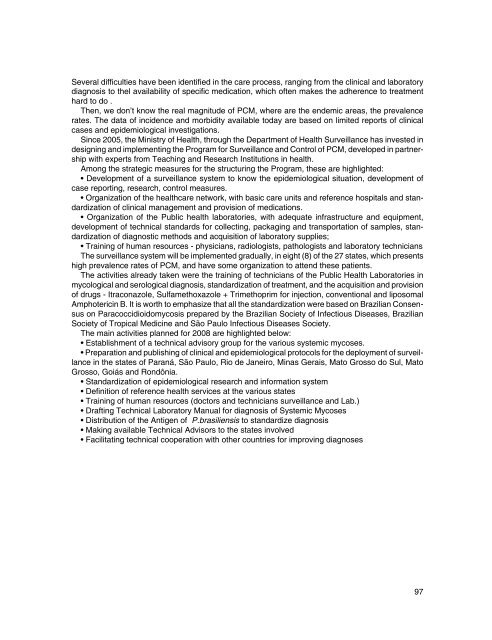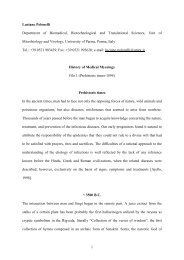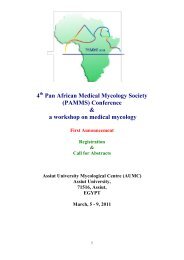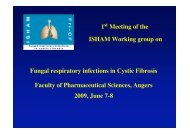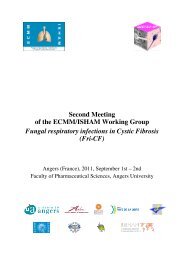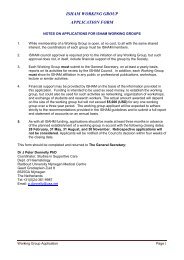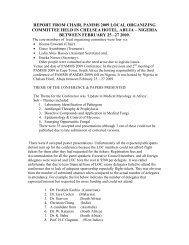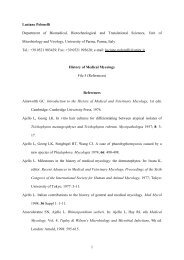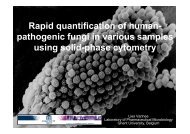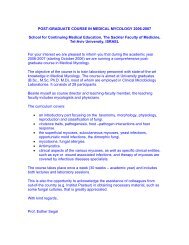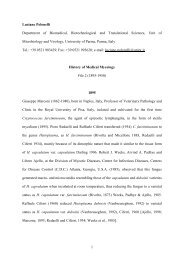after stem cell transplant (HCT) is 1.7% for all types of HCTs. The timing of IPA varies as well, withabout half of cases occurring after 90 days after transplant. Aspergillus fumigatus (43%) remains themajor agent of IPA followed by Aspergillus flavus and niger (8% each). Aspergillus terreus (5%) is aspecies of concern due to amphotericin B resistance. The 90-day mortality of IPA in HCT patients is50%. The incidence of IPA in solid organ transplant patients is 0.7% by 12 months post-transplant.Some studies have reported an increase in the incidence of zygomycotic infections after transplant.The TransNet network is studying this question. It is not clear whether this phenomenon is due toincreased survival after transplantation, or due to an increase in prophylaxis with azole drugs, whichhave limited activity against zygomycetes.Paracoccidioidomycosis in Brazil:Surveillance and control ProgramMaria Adelaide MillingtonHead of the Systemic Mycoses ProgramSecretariat of Health Surveillance, Ministry of Health, Brasília,Brasil.e-mail:adelaide.millington@saude.gov.brThe Secretariat of Health Surveillance, Ministry of Health from Brazil is structuring (initiating) theProgram for Surveillance and Control of Systemic Mycoses to determine the magnitude of theseinfections in the country.The Program mainly aims to estimate the prevalence and geographic distribution of Paracoccidioidomycosis(PCM), Histoplasmosis, Coccidioidomycosis and Cryptococcosis. Also other objectivesare: to estimate the mortality rates of each of these diseases, to make early diagnosis and timelyand properly handle (management) of the cases, to detect and control outbreaks, through adoptionof prevention and control measures, to support and promote the scientific-technical development inthe area, providing for the network of health services new diagnostic tools, treatment and control ofthese diseases.The Program will initiate the efforts with Paracoccidioidomycosis (PCM) because it is an indigenousmycoses, endemic in Brazil and represents an important Public Health problem by its high potentialdisability and premature deaths it causes, if not appropriately diagnosed and treated. Studying the period1980-1995, an author showed an annual mortality average rate of 1487 deaths/10 6 of inhabitants,and shows that the PCM is the eighth cause of chronic disease mortality, greater than leishmaniasismortality and the highest rate among the systemic mycoses. Most cases have been reported in thesouth, southeast and center-west of Brazil where It is endemic among the populations of rural area.PCM has been reported in areas of recent colonization most subject to deforestation, as in parts ofthe Amazon Region, where can be considered an emerging systemic mycosis.PCM is caused by the dimorphic fungus Paracoccidioides brasiliensis, that appears to be predominantlyin the chronic form in adults and in the acute or subacute forms when it affects children,adolescents and young adults. The PCM is acquired through inhalation of fungal particles dispersedin the air, from sites with contaminated soil.In Brazil, the systemic fungal infections are not reportable diseases, so they are not object ofroutine epidemiological surveillance and only in the states of Paraná, Rondônia and more recentlyMato Grosso do Sul, the PCM is a reportable disease. In these states the health care is organized,with reference services well defined, and it is subsidizing the Program in other Brazilian states.96
Several difficulties have been identified in the care process, ranging from the clinical and laboratorydiagnosis to thel availability of specific medication, which often makes the adherence to treatmenthard to do .Then, we don’t know the real magnitude of PCM, where are the endemic areas, the prevalencerates. The data of incidence and morbidity available today are based on limited reports of clinicalcases and epidemiological investigations.Since 2005, the Ministry of Health, through the Department of Health Surveillance has invested indesigning and implementing the Program for Surveillance and Control of PCM, developed in partnershipwith experts from Teaching and Research Institutions in health.Among the strategic measures for the structuring the Program, these are highlighted:• Development of a surveillance system to know the epidemiological situation, development ofcase reporting, research, control measures.• Organization of the healthcare network, with basic care units and reference hospitals and standardizationof clinical management and provision of medications.• Organization of the Public health laboratories, with adequate infrastructure and equipment,development of technical standards for collecting, packaging and transportation of samples, standardizationof diagnostic methods and acquisition of laboratory supplies;• Training of human resources - physicians, radiologists, pathologists and laboratory techniciansThe surveillance system will be implemented gradually, in eight (8) of the 27 states, which presentshigh prevalence rates of PCM, and have some organization to attend these patients.The activities already taken were the training of technicians of the Public Health Laboratories inmycological and serological diagnosis, standardization of treatment, and the acquisition and provisionof drugs - Itraconazole, Sulfamethoxazole + Trimethoprim for injection, conventional and liposomalAmphotericin B. It is worth to emphasize that all the standardization were based on Brazilian Consensuson Paracoccidioidomycosis prepared by the Brazilian Society of Infectious Diseases, BrazilianSociety of Tropical Medicine and São Paulo Infectious Diseases Society.The main activities planned for 2008 are highlighted below:• Establishment of a technical advisory group for the various systemic mycoses.• Preparation and publishing of clinical and epidemiological protocols for the deployment of surveillancein the states of Paraná, São Paulo, Rio de Janeiro, Minas Gerais, Mato Grosso do Sul, MatoGrosso, Goiás and Rondônia.• Standardization of epidemiological research and information system• Definition of reference health services at the various states• Training of human resources (doctors and technicians surveillance and Lab.)• Drafting Technical Laboratory Manual for diagnosis of Systemic Mycoses• Distribution of the Antigen of P.brasiliensis to standardize diagnosis• Making available Technical Advisors to the states involved• Facilitating technical cooperation with other countries for improving diagnoses97


